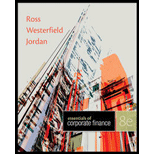
a)
To determine: The expected return on the portfolio of equally weighted Stock A, Stock B, and Stock C.
Introduction:
Expected return refers to the return that the investors expect on a risky investment in the future. Portfolio expected return refers to the return that the investors expect on a portfolio of investments.
a)
Answer to Problem 9QP
The expected return on the portfolio is 10.885%.
Explanation of Solution
Given information:
The
The probability of having a boom is 75 percent, and the probability of having a bust cycle is 25 percent.
All the above stocks carry equal weight in the portfolio.
The formula to calculate the expected return of the portfolio in each state of the economy:
The formula to calculate the portfolio expected return:
Where,
E(RP) refers to the expected return on a portfolio
“x1 to xn” refers to the probability of each asset from 1 to “n” in the portfolio
“E(R1) to E(Rn) ” refers to the expected
Compute the expected return of the portfolio of the boom economy:
R1 refers to the rate of returns of Stock A. R2 refers to the rate of returns of Stock B.
R3 refers to the rate of returns of Stock C.
Hence, the expected return of the boom economy is 11.63%.
Compute the expected return of the portfolio of the bust economy:
Hence, the expected return of the bust economy is 8.66%.
Compute the portfolio expected return:
Hence, the expected return on the portfolio is 10.885%.
b)
To determine: The variance of the portfolio
Introduction:
Portfolio variance refers to the average difference of squared deviations of the actual data from the mean or expected returns.
b)
Answer to Problem 9QP
Explanation of Solution
Given information:
The rate of return of Stock A is 7 percent, Stock B is 1 percent, and Stock C is 27 percent when the economy is in booming condition. The rate of return of Stock A is 12 percent, Stock B is 19 percent, and Stock C is −5 percent when the economy is in busting condition.
The probability of having a boom is 75 percent, and the probability of having a bust cycle is 25 percent and invested 20% in A and B and 60% in C.
All the above stocks carry equal weight in the portfolio.
Compute the portfolio return during a boom:
Hence, the return on the portfolio during a boom is 0.178 or 17.8%.
Compute the portfolio return during a bust cycle:
Hence, the return on the portfolio during a bust cycle is −3.2% or− 0.032.
Compute the portfolio expected return:
Hence, the expected return on the portfolio is 0.1225 or 12.55%.
Compute the variance:
The probability of having a boom is 75 percent, and the probability of having a bust cycle is 25 percent.
Hence, the variance of the portfolio is 0.00746.
Want to see more full solutions like this?
Chapter 11 Solutions
Essentials of Corporate Finance
- 7. Calculate the present value of $1,000 received in 3 years at 8% discount rate. need a ai ...??arrow_forward6. If sales are $100,000 and net income is $20,000, what is the profit margin? need a helpful..???arrow_forward5. Calculate WACC for a company with 50% debt (cost 6%) and 50% equity (cost 10%). Need a helpfully...???arrow_forward
- 2. A bond pays $50 annual interest with a face value of $1,000. What is the coupon rate? need a helfuarrow_forward3. If EPS is $5 and the stock price is $50, what is the P/E ratio? Need a helpful..?????arrow_forward1. Calculate the future value of $1,000 invested at 5% interest for 2 years. no gpt ..???arrow_forward
- 4. A savings account earns an annual interest rate of 2%. If you deposit $1,000, how much interest will you earn in one year? correct solution????arrow_forward1. If a stock's current price is $50 and it increases by 10%, what is the new price? Need a helpful..???arrow_forward2. A bond has a face value of $1,000 and a coupon rate of 5%. What is the annual interest payment? need a helpful????arrow_forward
- 4. A savings account earns an annual interest rate of 2%. If you deposit $1,000, how much interest will you earn in one year? step by step solution???arrow_forward5. If a stock's dividend yield is 4% and the stock price is $50, what is the annual dividend payment per share? no gpt???arrow_forward7. If an investment grows from $1,000 to $1,200 in two years, what is the compound annual growth rate (CAGR)? no gpt????..arrow_forward
 Essentials Of InvestmentsFinanceISBN:9781260013924Author:Bodie, Zvi, Kane, Alex, MARCUS, Alan J.Publisher:Mcgraw-hill Education,
Essentials Of InvestmentsFinanceISBN:9781260013924Author:Bodie, Zvi, Kane, Alex, MARCUS, Alan J.Publisher:Mcgraw-hill Education,

 Foundations Of FinanceFinanceISBN:9780134897264Author:KEOWN, Arthur J., Martin, John D., PETTY, J. WilliamPublisher:Pearson,
Foundations Of FinanceFinanceISBN:9780134897264Author:KEOWN, Arthur J., Martin, John D., PETTY, J. WilliamPublisher:Pearson, Fundamentals of Financial Management (MindTap Cou...FinanceISBN:9781337395250Author:Eugene F. Brigham, Joel F. HoustonPublisher:Cengage Learning
Fundamentals of Financial Management (MindTap Cou...FinanceISBN:9781337395250Author:Eugene F. Brigham, Joel F. HoustonPublisher:Cengage Learning Corporate Finance (The Mcgraw-hill/Irwin Series i...FinanceISBN:9780077861759Author:Stephen A. Ross Franco Modigliani Professor of Financial Economics Professor, Randolph W Westerfield Robert R. Dockson Deans Chair in Bus. Admin., Jeffrey Jaffe, Bradford D Jordan ProfessorPublisher:McGraw-Hill Education
Corporate Finance (The Mcgraw-hill/Irwin Series i...FinanceISBN:9780077861759Author:Stephen A. Ross Franco Modigliani Professor of Financial Economics Professor, Randolph W Westerfield Robert R. Dockson Deans Chair in Bus. Admin., Jeffrey Jaffe, Bradford D Jordan ProfessorPublisher:McGraw-Hill Education





